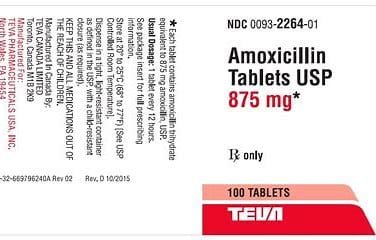Introduction

It is one of the major antibiotics used under the head of the penicillin family. It is effectively potent in most parts of the human body, especially through the respiratory, urinary system, ears, skin, and other parts that are attacked due to the bacterial infections, causing it to hinder the bacteria from synthesizing their cell walls, leading to quick recovery from these infections in all these parts of the body. Amoxicillin is available in various formulations and has become a first-line treatment for many diseases because of its efficacy, safety, and broad spectrum of action. This paper discusses the uses, types, advantages, and disadvantages of amoxicillin.
What is Amoxicillin?
Amoxicillin is a beta-lactam antibiotic derived from penicillium. It was synthesized as the first compound to inhibit and kill bacteria by damaging their cell walls. It is active against a wide variety of Gram-positive and Gram-negative bacteria. Amoxicillin is very useful in infections induced by the bacteria Streptococcus pneumoniae, Haemophilus influenzae, Escherichia coli, and other bacterial pathogens.
Forms and dosage of amoxicillin
Amoxicillin is given in various forms for easy administration to patients of all ages so that patients at any age can comply with medication. The tablets and capsules are the commonly prescribed amoxicillin dosed in 250-875 mg, which should be administered every 8 to 12 hours according to the seriousness of the infection to adults and other older children.
Liquid Suspension: For patients who cannot swallow tablets, the available flavor options can be used in multiple strengths.
Chewable Tablets: They also come as chewable tablets for use with children.
Extended-Release Tablets: These are used for some conditions, like tonsillitis or strep throat, where the prolonged release of the antibiotic is helpful. The 775 mg formulation of amoxicillin extended release is taken once a day for convenience.
Uses of Amoxicillin
Amoxicillin is used for a wide range of infections due to its broad efficacy. Some of the common uses include:
Respiratory tract infections: This drug is mostly given in cases such as sinusitis, bronchitis, and even in cases of community-acquired pneumonia. It curbs the symptoms and brings away the infection fast.
Middle Ear Infections (Otitis Media): Antibiotic Amoxicillin generally treats the middle ear infections caused in children pretty efficiently because the bacteria that are used for infection of the ears are killed because of its existence.
Urinary Tract Infections: It is active against some strains of E. coli, although often sensitivity testing is recommended as resistance is rising.
Skin Infections: Skin infections such as impetigo and cellulitis are responsive to amoxicillin provided the offending organism is sensitive to amoxicillin.
Gastrointestinal Infections: This drug can be used to treat Helicobacter pylori infections when combined with other drugs. This combination is helpful in the treatment of ulcers and certain types of gastritis.
Dental Infections: Since this drug is very effective in combating oral bacteria, this drug is also commonly applied in the management of dental abscesses or infections before or after dental procedures.
Advantages of Amoxicillin Broad-Spectrum Activity:
It is very effective against a wide variety of bacteria. This medicine can be used to treat multiple infections in one setting, thereby avoiding the use of multiple antibiotics.
Generally Tolerated: It has a mild side effect profile, which makes it suitable for most patients. It can be used for children and pregnant women with proper medical supervision.
Easy availability and low cost: Being a generic drug, it is low-cost and easily accessible, which enhances patient compliance and accessibility to treatment.
Quick relief from symptoms: Most patients will begin to feel better in their symptoms within a few days of initiating the treatment due to the quick action of the antibiotic.
Variety of forms for convenience: With tablets, capsules, suspensions, and extended-release forms, amoxicillin can be suited to the needs of various age groups and preferences.
Disadvantages of Amoxicillin

Antibiotic Resistance: Due to overuse, it has rendered some bacteria resistant to amoxicillin but not as potent for all infections, such as UTIs caused by resistant E. coli strains.
Possible Adverse Effects: Although it is generally well tolerated, the following possible adverse effects may occur in some patients: nausea, vomiting, diarrhea, and rashes. Anaphylaxis can occur in very rare cases.
As with most antibiotics, amoxicillin interferes with the normal gut flora and its side effects may include diarrhea or, in rare cases, antibiotic-associated colitis.
Interaction with Other Medications: Amoxicillin may interact with some other drugs like anticoagulants, which increase the risk of bleeding. Patients on other medications should consult their doctor before using amoxicillin.
Allergic Reactions: Amoxicillin is a penicillin derivative that can cause allergic reactions in individuals who are allergic to penicillin. The symptoms can be very mild (skin rash) or very severe (anaphylaxis) and usually require urgent medical attention.
Amoxicillin Combinations
There are several amoxicillin combinations as the drug is often prescribed in combination with other drugs to improve its efficacy against certain pathogens.
Amoxicillin-Clavulanate (Augmentin): Clavulanic acid is a beta-lactamase inhibitor that, in combination, reverses bacterial resistance, allowing for the use of amoxicillin on bacteria that would not be otherwise susceptible. Thus, it is used when a person has sinus, skin, and a bit more complicated infections in the respiratory area.
Combination of Amoxicillin with Proton Pump Inhibitors and Clarithromycin: This is a form of application to combat H. pylori, the bacteria causing peptic ulcers. The use facilitates the killing of the bacteria.
Consideration of Use and Practice Recommendations
A full course of amoxicillin should be taken as directed to cure an infection with few side effects. Skipping doses or stopping treatment early leads to resistance and a recurrence of the infection. Liquid amoxicillin also should be refrigerated, where it will retain its potency for 14 days. Discard after that.
Conclusion:

Amoxicillin remains one of the most commonly used antibiotics given its versatility, cost-effectiveness, and safety profile. Its broad efficacy against a wide range of infections makes it invaluable, but growing antibiotic resistance demands judicious use. Understanding the advantages, disadvantages, and available formulations will enable patients and healthcare providers to maximize the effectiveness of amoxicillin while minimizing the risks associated with its use.



